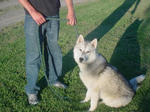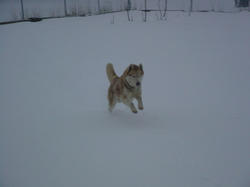

|
Supplies Needed: On this page, we will outline some of the items you will need for your new puppy or adult, as well as other important considerations. Each of the following will be outlined below in more detail: |
|
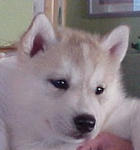 |
Crate Crates come in all different sizes and types. There are plastic crates, metal crates, wicker crates, etc. There are small, medium, large, and extra-large crates. If you are having your puppy or dog shipped, you will need an airline approved crate. Typically a 'Large' crate is sufficient for an adult Siberian. If you're getting a puppy, rather than get one of each crate size as your puppy grows, beginning with a Large crate is more economical. We generally use a plastic crate, as the metal crates make it easier for the puppy or dog to reach items outside of the crate and pull them in for a possible snack. For information on crate training, please visit: Large crates can be purchased at many stores for around $68.00, and they are available at many online stores as well.
|
| Grooming For bath time, we use Plush Puppy shampoos and conditioners. There are different formulas for different coat colors and different purposes (such as keeping whites white). Get Shampoo, Conditioner, and we really like the Conditioning Mousse. You can order here: or email kristari@aol.com For brushing/combing, you will want to get a steel comb that has wider spaced teeth on one side, and narrower spaced teeth on the other. Any wire ended brush will do for routine brushing. Comb: 'Classic Combination Comb' Brush: 'Large Comfort Tip Brush' When a Siberian blows coat (usually about twice a year), it is a mess. If you are unfamiliar with this breed characteristic, please visit our 'Breed Characteristics' page. When this happens, you can brush from sun-up until sun-down and it seems like the fur will still be coming out. During this period, it is advisable to wet your dog down, and blow dry large amounts of the fur out, while combing at the same time. For this, you will want to order a hair dryer for dogs, or reverse the action on a shop-vac. A human hair dryer does not have the force needed to blow the hair out. Since this can also be messy and time consuming, you may decide just to take your dog to a groomer in an effort to reduce the amount of hair that you are vacuuming up and combing out yourself. Many of these items can be found at: http://www.carealotpets.com or one of the other dog product supply stores. Dryer: Grooming Table: Grooming Apron: *Note: Bathe your Siberian regularly as a puppy. Some Siberians LOVE bath time, and others do not. If you have one that does not, and wait until he/she is older for his/her first bath, you may have your hands full! With the amount of digging that young Siberians like to do, odds are that you will be doing that anyway! |
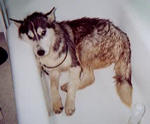 |
 |
Dinner Time We feed National Dog Food, Competition Extra formula (pellets), and Performance Plus formula (kibble). National is independently manufactured in Wisconsin and we have it delivered here through a distributor in our state. We will send you home with a small bag of food; however, if your puppy/dog is being shipped, we are more limitted on how much food we can attach to the top of the crate. If you intend to change the type of food your puppy/dog is being fed, the switch should be done so gradually to avoid any adjustment problems. We recommend that you have a larger bag of National on hand to make this transition easier on your and your dog/puppy. It can be ordered from National, check for a local distributor, or you can pre-order it from us and we can have it ready upon pick up. http://www.nationaldogfood.com If you do not intend on continuing to feed National, there are other quality foods available. We've also fed Iams/Eukanuba:
Bowls Some Siberians like to play and dig in their water dishes. You'll want to get the kind with a wider bottom to avoid tipping as much as possible. There are plastic holders that bowls can be placed inside that help to deter the bowls from being knocked over. Glass bowls and crockery are breakable, even if they're heavy. The advantage to a taller food stand for older dogs is that they don't have to bend over to reach their food. Bowls: http://www.carealotpets.com |
| Collars and Leashes Since Siberians are sled pullers by nature, you will want to start early with training. Basic obedience and handling classes are highly recommended. There are kennel clubs and obedience clubs in most major cities, and in many smaller towns, as well, that offer classes. These are great for socialization as well. Kennel Club Listings: If your schedule is limitted, there are also trainers that offer private classes. These are generally more expensive, and don't offer as much in the way of socializing your puppy/dog, but certainly another option. Examples of Private Trainers in PA: Trish Worden: nichshred@hotmail.com Matt Drehler: matt1632d@yahoo.com There are different theories on how to begin training dogs/puppies. Please consult a professional trainer for further information on the different handling approaches. We usually begin with a nylon choke collar so that the collar is less likely to slip off over your dog/puppy's head, and a basic leash with a pull clasp as opposed to thumb clasp that may get caught on something and accidentally release your dog or puppy. (If you have an adult that is prone to pulling, a thicker leash is easier on your hands). Nylon Choke: Leash: Show chain: Since Siberians are not trustworthy off-lead, Retractible or 'Flexi' leashes are great for allowing your puppy/dog some extra line to run/explore. There is some degree of training involved with this type of lead in that you don't want your puppy to learn to lunge or run out to the end of the line and yank your arm out of the socket. You'll want a heavy-duty flexi. Additionally, since Siberians are also highly predatory, you need to be alert and aware of small animals in the area you are walking. Extra lead gives your Siberian extra opportunities to locate birds, bunnies, etc., as well as. Flexi Leash: http://www.carealotpets.com |
 |
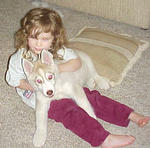 |
Chew Toys Puppies of any breed like to chew. Providing alternatives to furniture, carpet, trim, clothing, etc. is highly recommended. Just like child-proofing your house, you will also need to puppy proof your house. Socks in the intestinal tract have to be removed by expensive surgery... Carpet fibers in the lungs can kill a dog... Many household plants can be dangerous to your pet... Your neighbor's kitten will not make you any friends... PIG EARS - Many puppies/dogs love 'pigs ears' and 'hooves' - beware of bacteria with these products. RAWHIDES - My dogs/puppies love rawhide chews. You need to monitor their consumption, though, as when the chew becomes to small, there is a risk for choking. TREATS - Use in moderation and for training. Too many treats can make your dog/puppy fat, possibly sick. Not to mention, it can spoil their supper if too many are being fed! The same goes for table food. Some bones/treats have colored dyes and other ingredients which may produce allergic reactions. STUFFED TOYS - Don't give your puppy anything of sentimental value, as it will eventually be destroyed. Small parts and plastic eyes will be removed and ingested. *Note: Some Siberians have a tendency towards being possessive of their food, toys, chews, etc. Be sure to carefully monitor this behavior and be sure that your Siberian understands that you (and your children) are above them on the totem-pole of authority. You may need to train them to release such items.
|
| Fencing Siberians are escape artists. Any outside means of containment must be secure. Fencing should be no less than 5 feet high, preferably 6 feet. The perimeter should be secured to deter digging out, (side walk blocks, fencing laying flat, etc.) ... and nothing that a Siberian could climb up onto to assist jumping over should be stationed along the inside of the fence. If the fence is privacy/wooden, it should be checked for structural weaknesses (if there are any, your Siberian will find it), and again, something should be along the bottom so that they cannot dig out. If the fence is chain link, the mesh should be small - (1" is typically the smallest you can find), as the bigger the hole through the link, the easier it is for a Siberian to get his/her feet into them and climb right up. Yep, they'll do it! Do not chain your dog in an enclosed area within reach of an outside wall, as if they do manage to get up and over, they may hang themselves. Invisible fencing - we've talked to some folks who have had some success with this method and their Siberians, but we cannot in good conscience recommend it for the following reasons: 1. Collars - Siberians have thick fur, and may not receive an adequate enough shock when crossing that invisible barrier. 2. Training - This method requires consistent training and monitoring. Siberians learn very quickly that if they get a certain distance beyond the underground fence that they will no longer receive the shock. After that point, this containment device is useless. 3. Prey Drive - A Siberian has a high prey instinct. If he/she has not been raised in the company of small animals, they may instinctively hunt bunnies, birds and other small game. This prey instinct will typically over-ride any amount of training telling him/her to respect a boundary when another animal is on the other side. 4. Outsiders - If you're lucky, and have gotten your Siberian to respect the boundaries of your underground fence, stray dogs and stray people still have access to your beloved pet. Stray dogs can carry diseases and parasites, cause unplanned breedings, injuries, etc. and stray people can taunt/abuse your dog, steal your dog, feed him/her something dangerous, and possibly cause you to be required to have increased homeowners insurance costs or be involved in a lawsuit. *Note: For safety purposes, Siberians should not be left outside unattended for any length of time. Kennels - A kennel, or small enclosure should follow the same parameters as above - preferably 6 feet high, smaller mesh, protected perimeter, or set on cement. Many department store chains sell small kennels - usually 10' X 10'. Beware of these methods of containment, as if they are a higher gauge of wire (poorer quality), a Siberian can chew right through the fencing. The metal poles are not sturdy enough, and a Siberian can tug on them and bend them. Where the chain link attaches to the poles, there are weaknesses - they can nose up the edges, leaving an escape point. There is typically a lot of space where the gates attach to the panel, and depending on the type of latch, Siberians can typically open them with ease. A kennel with more structural integrity is highly recommended if you plan on having your dog outside some of the time. We use Mason Kennels in Ohio: Mason kennels: http://www.masonco.com *Note: Siberians require a lot of time and attention. We don't sell dogs as pets to homes where they will be kept strictly outside. Siberians are not watch dogs. Exercise Pens: Small collapsible pens are okay for puppies or traveling if you plan on being nearby. These should not be used as a means of permanent outside containment. X-Pens: http://www.carealotpets.com
|
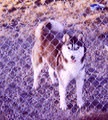 |
Housebreaking
The most common requests for information that we get from people who have recently purchased puppies are those concerning housebreaking. Originally, we were going to include a list of related links; however, upon further scrutiny, we decided that it might be best to simply include the techniques or recommendations that have worked best for us.
Preliminary:
|
|
| Additionally... When you pick up your dog/puppy from us, please bring 2 copies of our pet or show contract with your contact information and signature on both. Thanks! Pet: http://www.siberianhusky.ws/pdffiles/puppycontract.pdf
|
|
|
|
|
We can accept online payments through PayPal |
|

